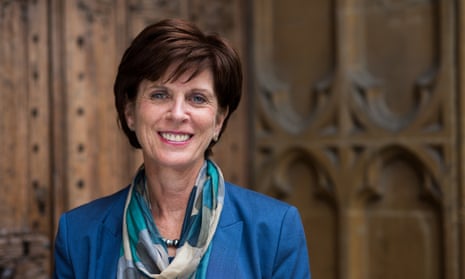The vice-chancellor of Oxford University has said her institution’s progress in tackling inequality and disadvantage remains slow, despite figures that show record numbers of women, state-educated pupils and students from black and minority ethnic backgrounds were admitted last year.
The proportion of students from UK state schools rose above 60% for the first time, and more women than men were admitted for the second year in a row. A record number of undergraduates with disabilities also joined the university.
The review, however, highlighted wide variation among 29 of the university’s colleges, which are responsible for their own admissions. While 90% of students at Mansfield came from state schools, but the figure for Trinity was only 48%.
Several colleges continued to lag behind the university averages by other measures, with Balliol admitting nearly twice as many men as women.
Louise Richardson, Oxford’s vice-chancellor, said the university’s concern at the slow rate of progress was behind its recent announcement of policies designed to increase the proportion of successful applications by students from disadvantaged and underrepresented backgrounds.
“From first glance at this data it is immediately apparent that Oxford University reflects the deep inequalities in our society along socio-economic, regional and ethnic lines,” Richardson said. “It must also be apparent, even to the most cynical observer, that we are making progress. The numbers are low, the pace is slow, but the trajectory is clear. The number of students admitted to Oxford from deprived backgrounds is steadily increasing.”
The new programmes include a foundation year for talented students lacking the required entry grades, and extra support for disadvantaged students before starting their undergraduate studies.
“The entire university community – colleges and halls, departments and divisions – have united behind a commitment to effect a sea change in our admissions practices,” Richardson said.
Oxford said the proportion of BAME students made up more than 18% of its UK admissions in 2018, compared with 13% in 2014. Among black students the proportion rose from 1% in 2014 to 2.6% last year, more than doubling the number admitted from 27 to 65.
The university also said the number of applicants from Bangladeshi and Pakistani backgrounds had risen substantially over the same period, with admissions doubling from 21 to 41 last year.
A number of colleges, however, are still struggling to improve the proportion of black students admitted. Brasenose received 45 applications from black students between 2016 and 2018 but only offered places to two, only one of which was accepted.
Individual courses also showed significant variations in applications from black students, with biological sciences, biomedical sciences and earth sciences making no offers at all in the three years to 2018. Music received just four applications over the same period, and only one admission.
The annual report revealed a slight tip toward international students compared with those from the UK. The 2,570 UK students admitted in 2018 made up 77.7% of of the university’s total intake, the lowest proportion on record. Those coming from outside the EU continued to rise to 573, accounting for more than 17% of admissions.
Oxford admitted 320 students from China and 206 from Singapore between 2016 and 2018, but only 217 from Wales and 145 from Scotland. International students pay about £25,000 a year in tuition fees for many undergraduates courses, compared with £9,250 for UK students.
